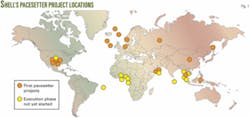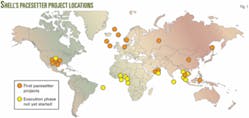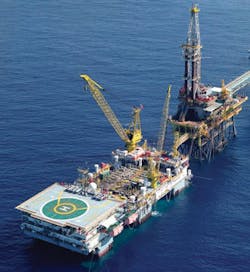Shell has revitalized its “Technical Limit” program in well delivery and well servicing activities. Early positive results have prompted the company to extend the program to additional assets in 2007 (Fig. 1).
The concept of technical limit (TL) arose in the late 1990s and quickly spread across the industry.1 Led by Shell’s technical-limit drilling approach, TL got well engineers to work toward a “perfect world” execution of their operations by removing lost time and adopting innovative practices.2 3
Shell achieved global success with the program, which eventually became known as “Drilling the Limit” (DtL).1 Driven by a team of performance consultants supporting a global project base, many projects achieved step changes vs. historical performance levels. In retrospect, however, uptake was patchy and the performance was not sustained in some areas.
Top quartile challenge
By 2004, achieving industry top-quartile performance became a priority for Shell. The goal was to translate this strategy into a practical program to apply globally. Workers within the company’s Wells discipline (Wells) felt that the response should be to revitalize DtL rather than to create a completely new performance initiative. Shell selected this revitalization approach, “rDTL,” for two reasons:
- DtL had been successful in many areas and clearly contained many of the necessary elements for success.
- The DtL name and brand were already familiar, reducing “initiative fatigue” in the organization.
The approach needed to be broadened and adapted, however, to cover aspects of performance that had not been addressed before and also to imitate operating units where DtL had been successful. To some, an environment for performance comes naturally; rDTL aimed to offer a framework for all projects on how to create such an environment.
In particular, the revitalization effort focused on:
- Addressing Wells performance throughout concept, design, and execution, rather than purely focusing on execution.
- Defining “performance” via three cross-disciplinary measures ($/ft, wells unit development cost, and production attainment vs. plan) rather than focusing on execution-time performance.
- Approaching performance as a “change journey,” in which direction setting, leadership engagement, and continuous communication all underpin the performance agenda.
- Embedding ownership for performance in the group, rather than it being the preserve of “fly-in-fly-out” consultants.
- Starting small and scaling fast, obtaining early successes, and learning before expanding the program.
Six elements of rDTL
Combining DtL with change management and human performance revitalized “Drilling the Limit,” the most comprehensive performance program ever applied in Wells. The program consists of six elements:
- Set targets that beat the competition based on action plans.
- Relate individual appraisal and rewards to business performance.
- Measure and communicate business performance.
- Improve decision quality within project management processes.
- Train subordinates for performance.
- Mobilize all players in the well-delivery discipline to improve performance.
While the program may at first sight appear complex, at its core are three simple issues: setting performance targets, setting plans to reach those targets, and creating accountability for their delivery.
Around this core, approach and emphasis of the program have been different across the 18 global “pacesetter” projects in which rDTL has been focused in its first year. As demonstrated in the following case studies of three high-performing teams, each took the essential elements of rDTL and delivered outstanding performance in very different environments.4
Europe-Arctic III
In Europe, Shell’s Arctic III team deployed rDTL in phases which helped the team create a heightened focus on performance and reset expectations.
The team focused resources to support the project’s performance expectations. Unlike the first iteration of DtL, however, in which performance consultants were often on the rig site, the new program was focused onshore. Consultants supported the project team throughout the project planning and execution in keeping performance at the top of the agenda.
In 2006, the team delivered five wells in top quartile vs. industry peers, saving 87 rig days-or $25 million-vs. plan. This performance enabled two additional wells to be drilled and resulted in 30% more production than had been planned.
The Arctic III team’s approach, based on the rDTL program, created a high-performance environment. Artic III implemented all six elements of rDTL and reached its successes through precise target setting, strict planning and raising the team’s awareness of performance, for instance by creating clear accountabilities and a reward culture.
Americas-Pinedale
Shell’s Rocky Mountains well delivery unit in Denver has a similar story of high performance.
After acquiring this tight-gas asset from McMurry Energy Co. in 2001, Shell’s operation has continued to face local competitive pressure. In early 2006, however, rDTL helped add focus and structure to the team.
For Pinedale, 2006 was about delivering on-performance targets that were already ahead of the leading local competitor. All three cross-disciplinary performance measures in rDTL were adopted: $/ft, wells unit development cost (UDC), and production attainment vs. plan.
The results were:
- 60 wells drilled and 55 completed, all on plan.
- UDC coming in just ahead of a tough target (against competition).
- Team exceeded its target of added production and reached a total of 500 MMcfd.
A crucial element of rDTL is the performance staircase, which links expected performance effects to a detailed, improvement plan. The contents of the staircase-technical, commercial, or process improvements-form the core of the team’s preparation for the year, creating focus and structure, and allowing the team to work only on activities that will have a major impact. In its drilling and completion activities, the Pinedale team used the staircases to focus the team’s activities and to ensure that performance targets were based on facts, not aspirations.
The Pinedale team also developed a program of clear, simple, performance-based incentives with staff and key contractors. These incentives-all related to bottom-line delivery of the three key performance indicators-were replicated by several other rig teams.
In the spirit of continuous improvement, the Pinedale team further tested themselves in early 2007. Looking for new improvement opportunities, the team brokered a performance-benchmarking project with all of its local competitors.
In the study, the teams shared performance data, which further strengthened the Pinedale team’s belief that its current performance and future targets were systematically outperforming the competition. Shell wells at Pinedale are top quartile, drilling costs are significantly lower than competitors, and days/1,000 ft drilled are significantly better than competitors.
Asia-Sarawak gas
In Asia, the big-bore gas wells of the Sarawak gas program (Fig. 2) will deliver 25% of LNG imports in Japan and Korea, and 20% of Shell’s Asian production. It was therefore critical that the team achieve promised production levels at competitive cost.
In contrast to some other projects, the Sarawak Gas team did not apply dedicated performance staff to support its campaign, opting for performance to be a team responsibility.
Clarity of targets was considered vital to the team’s success and, consequently, the team’s performance objectives were rolled up into a drive for the “21-day well.” The results were impressive, with $/ft and UDC both coming in at less than 70% of the project baseline. The team had the company’s highest performance vs. project baseline for the year.
Lessons for industry
These case studies demonstrate the variety of approaches that can be taken to achieve high performance. Shell’s experience has taught its rDTL team three unbreakable rules:
- Set unambiguous targets tested against external performance markers, and hold people accountable for delivery.
- Relentlessly communicate learning and success.
- Ensure that facts and results are easily available to ensure high-quality discussions and avoid debate around the numbers.
rDTL’s future
Based on its success in 2006, the rDTL program for well delivery is being expanded to a new wave of projects.
The program has been extended to support Shell’s well-servicing activities. In this new avenue, the best learning from the well-delivery program has been adopted, and in partnership with asset production teams, well-services teams are well on track to achieve top quartile in Wells.
References
- Bond, D.F., Scott, P.W., Pager, P.E., and Windham, T.M., “Step change Improvement and High Rate Learning are Delivered by Targeting Technical Limits on Sub-Sea Wells,” IADC/SPE 35077, IADC/SPE Drilling Conference, New Orleans, Mar. 12-15, 1996.
- Schreuder, J.C., and Sharpe, P.J., “Drilling the Limit-A Key to Reduce Well Costs,” SPE 57258, SPE Asia Pacific Improved Oil Recovery Conference, Kuala Lumpur, Oct. 25-26, 1999.
- Hashmi, N.A., Foy, John, and Kohnert, Jorg, “Delivering Exceptional Performance in the Ketch Field,” SPE 67817, SPE/IADC Drilling Conference, Amsterdam, Feb. 27-Mar. 1, 2001.
- Al-Suwaidi, Abdullah, Faure, Alban, Mukhalalati, Talal, Rahman Al-Tawil, Adul, and Bamajbour, Abdul Rahman, “Well Delivery Limit (WDL): ADCO’s Approach to Breakthrough Performance,” IADC/SPE 72317, SPE/IADC Middle East Drilling Technology Conference, Bahrain, Oct. 22-24, 2001.
The authors
Alban Faure ([email protected]) is deputy general manager, Wells, at Shell Petroleum Development Co., Warri, Nigeria, with responsibility for improving well performance. He has more than 30 years’ experience in a variety of well engineering positions in operations, engineering, R&D, and management. He holds a degree (1974) in civil engineering from Centre National des Travaux Publics de Toulouse France, and completed a postgraduate course (1981) in drilling engineering at Ecole Nationale du Petrole et des Moteurs, Rueil. Faure is a member of SPE.
Peter Hendriks ([email protected]) is a performance improvement manager at Shell, Rijswijk. He has 17 years of well engineering experience in both operational and support roles, working in the Netherlands, UK, Syria, and Oman. Hendriks holds a PhD (1990) in physics from the University of Technology Eindhoven in the Netherlands.
Norbert van Beelen ([email protected]) is Sarawak well-delivery team leader for the big-bore gas wells at Sarawak Shell Bhd., Lutong, Malaysia. He joined Shell in 1988 and held positions as assistant driller, driller, drilling supervisor, and well engineer before taking his current position. He holds a BSc (1986) in oil and gas engineering from Technnisch Hogeschool, Amsterdam, and is a member of Fédération Européenne d’Associations Nationales d’Ingénieurs.
Mudassar Kazi ([email protected]) is a well engineer for Shell, Aberdeen. He has 9 years of well engineering experience in operations and performance improvement. Mudassar was part of the rDTL team in Europe. He graduated with a first class honors degree in chemistry from Bristol University, UK.
Jeff Wahleithner ([email protected]) is well delivery manager-Rockies for Shell, Denver. He has also served as project manager, superintendent, and other roles in drilling and production engineering and operations onshore and offshore in the Lower 48 US, Alaska, and the Middle East. Wahleithner holds a BSc (1982) in civil engineering from the University of Utah and is a registered Petroleum Engineer in California. He is a member of SPE.
Ivo Wenzler ([email protected]) is a senior executive (partner) in Accenture’s human performance service line, Amsterdam, and is also associate professor and researcher at Delft University of Technology. Wenzler holds a bachelors (1981) in architecture and urban planning, University of Zagreb; a masters (1986) in urban planning; and a PhD (1990) in business simulations and gaming, both from the University of Michigan at Ann Arbor. He is a member of the Society for Organizational Learning and the International Simulation and Gaming Association.
Philip Whittaker ([email protected]) is a senior manager for Accenture’s energy team, London. He has worked on upstream business strategy and performance issues with a wide variety of operators, NOCs, and service companies. Prior to his consulting career, Whittaker was a well engineer and drilling supervisor with Shell International E&P. He holds a BEng (1993) in civil engineering from the University of Leeds, UK, and is a chartered engineer. Whittaker is a member of the Institution of Materials, Mining and Metallurgy.


